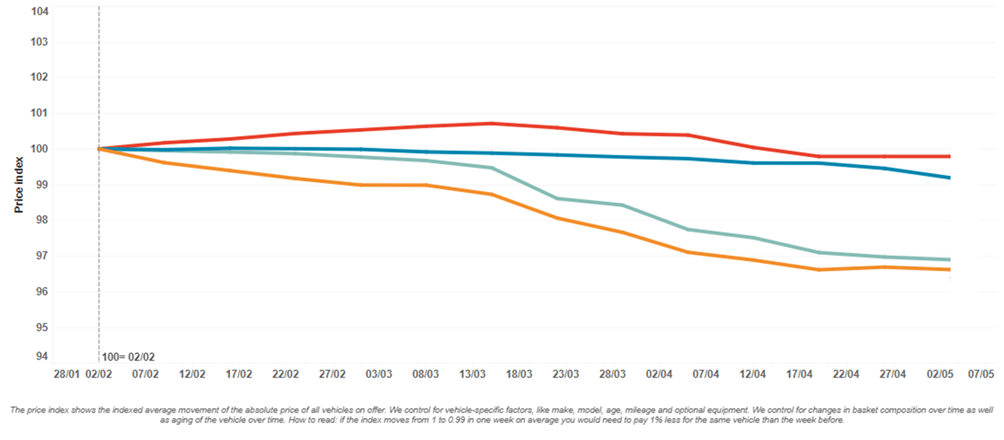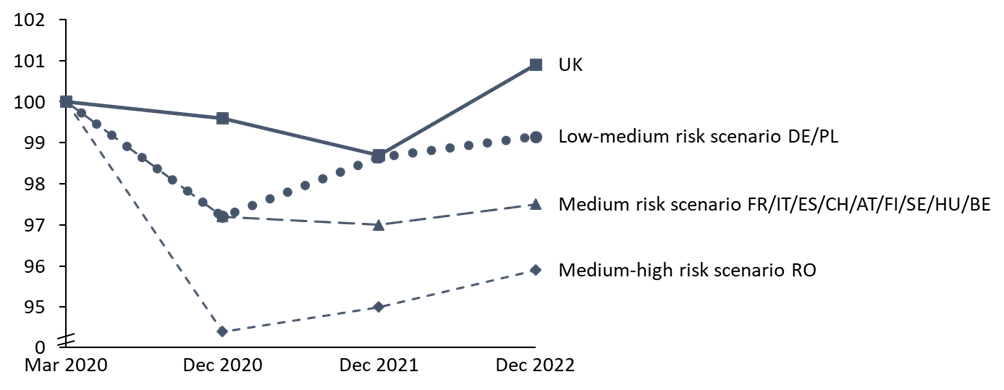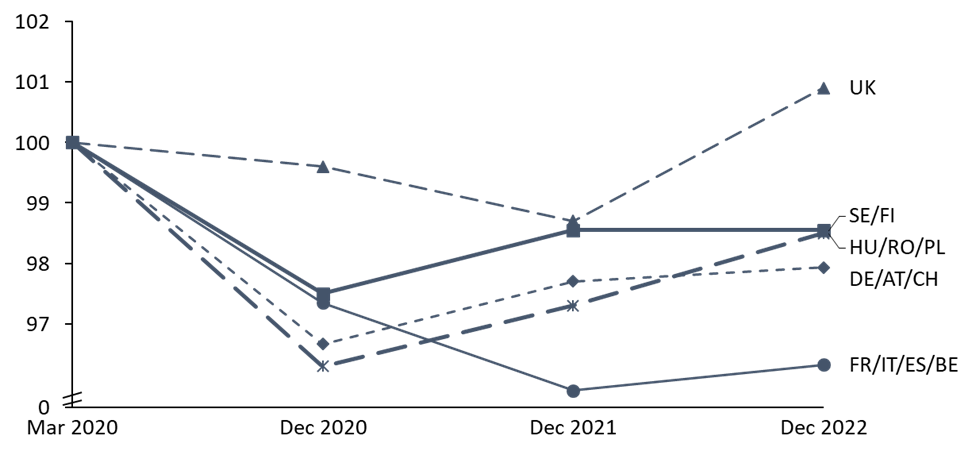How will COVID-19 shape used-car markets – May 2020 update
08 May 2020

The May update of Autovista Group’s whitepaper: How will COVID-19 shape used-car markets? considers the ongoing impact of COVID-19 across Europe.
€1.8 billion of economic losses for dealers in Europe
We have covered the grinding halt of the automotive industry and the impact of the lockdown in several stories and podcasts over the past weeks. The industry is slowly emerging from the lockdown in some markets. After Austria, Germany has entered the ramp-up phase. France and Spain continue on the lockdown path, but with some easing. These steps, even if they feel small, are crucial, as we need to move back to a new normal. The main reason is that economic losses, which have been building up, are tremendous. For dealers in Europe the amount to €1.8 billion for their used car operations alone since the start of the lockdown until 18 April 2020.
In Table 1, we have laid out the mechanics of this estimate. There are three elements to the calculation.

One, there are – albeit currently small – losses in residual values observed across markets for the period of the lockdown. We expect them to continue to build up over the coming weeks and months and have laid out our scenarios later in this whitepaper.
The main reason for the pressure on RVs is the economic crisis that is building. Latest forecasts estimate economies in Europe could contract by 7% or potentially more in 2020. Forecast institutes do not anticipate a quick economic recovery and this will wash through to purchasing power and private demand.
We also see a more negative development of used car prices in countries, that have had no or a more relaxed lockdown but more exposure to the economic impact of the crisis. Used car values in Sweden, which did not enforce a lockdown and Finland, where dealers remained open over the past weeks, show a bigger decline in RVs than those markets that had largely shut down, e.g. France and the UK (Figure 1). The economic pressure to reduce prices that dealers are experiencing may outweigh any inflationary benefits from pent-up demand and shortage of new car supply.
Secondly, stock days rise during lockdowns and each day costs money, in particular associated to lending. We estimate that these costs are around €10 per day of lockdown.
Thirdly, we estimated the loss in value due to the ageing of the individual vehicle. These costs come on top of the cost incurred due to capital employed.
Figure 1: Used car price index for selected markets

Source: Autovista Group, Residual Value Intelligence (RVi), COVID-19 tracker
Fending off coronavirus – measures post lockdown at car dealerships
Economic losses keep building up the longer markets remain shut. Pressure will rise on dealers to turn stock quickly once they re-open. During the ramp-up phase and throughout this year, it will be important for OEMs to support dealers financially and help them to implement appropriate programmes and tools to engage with customers. For dealers it will be pivotal to avoid giving in to the temptations of discounting.
The ramp-up phase, the phase after the lockdown of vast areas of social and economic life, is characterised by uncertainty around how customers will react to the stricter rules of engagement. It will tell us how big the appetite is to shop for a car. It is a period without precedent and one that sets the tone for any upcoming phases. Mistakes made during this phase may affect you down the road.
One of the most annoying things when shopping for a car is the haggling for the best price. The expectation of many customers is that the price published on a web portal or the dealer website is a ballpark figure. Savvy buyers do not shop for one car but visit several dealers, leave and come back again later. This strategy was time-consuming before the pandemic. Now it is excessively so. Dealers will not be able to sell like this. We now need more efficient, digitally enabled shopping experiences. With half of the face covered by a mask, price negotiation ambitions should be lowered to a minimum as well.
Look for alternatives to discounting during the ramp-up phase
Stock had been building up in many markets due to short-term registrations towards the end of last year, in part to avoid those vehicles being accounted for in CO2 emission calculations and resulting fines. Springtime is usually a period of excellent business for car dealers and this period has been lost to traders across many European countries. With economic pressures building, dealers could offer straightforward discounts to attract used car buyers. We will see dealers do it, but it will be a mistake, as it establishes a downward-pressure on vehicle prices – new and used –for the remainder of the year. There are alternative ways to create an attractive offer that should stimulate demand for cars.
Leasing, financing and other benefits
It is likely that we will see some pent-up demand over the coming weeks, but it is equally likely that consumers are standoffish when it comes to making longer-term financial commitments like those associated with a traditional vehicle purchase. Stimuli may be needed to live through the ramp-up phase and there are powerful and smart ways to hide discounts: dealers should focus their attention on offering excellent leasing and financing conditions. Discounts can be incorporated via free service components, 0% financing, no down payments or delaying the first instalment by several months. There may be other impactful ways for dealers to offer a benefit without talking discounts, e.g. an extended right to cancel the contract or shortened leasing periods.
Used car leasing and car subscriptions
In periods of economic uncertainty, flexibility is key. Long-term financial commitments are challenging to obtain. This may be the time in which used car leasing and subscription models see a surge in demand, and there are several start-ups and incumbents in this line of business already. These business models, if dealers are integrated into them, would help soften the crisis during this transitional period.
Individually, dealers and dealer groups can think about creating intriguing offers for smaller businesses and fleets. What is a company with 5-10 company cars looking for? How can you offer financial flexibility to those businesses?
E-commerce as a response to an anticipated second wave of the pandemic
The coronavirus pandemic has painfully proven that the lack of digitisation of the automotive sales and marketing value chain is a burden that the industry must overcome. In the absence of access to shops and dealers, customers have focused their attention on e-commerce. An omnichannel strategy will be more resilient than other single-channel strategies in the future.
“Alternative concepts for keeping up the business in the digital space may prevent dealerships from going out of business, especially when considering a possible second or third wave of the pandemic,” claims Roland Strilka, Director of Valuations at Autovista Group.
Dealers need to work on an inclusive strategy, which conserves the achievements of physical reach and network coverage. Both are crucial ingredients for addressing customer needs going forward, irrespective of the business model.
Coronavirus scenarios – how swiftly will economies recover?
To support analysis of the impact of the coronavirus on the automotive industry, we have developed a number of scenarios. The scenarios are based on risks associated with the following five mandatory parameters, as well as other country-specific factors that influence residual value (RV) development:
- How long until the spread of infections is contained;
- The economic outlook for 2020, 2021 and 2022;
- On the supply side, expected issues in the supply chain for new car production;
- On the demand side, development of private consumption over the coming years; and
- An assessment of how effectively fiscal and monetary policy measures are working.
Views on the global economy darken
Since the publication of the previous version of this report at the beginning of April 2020, the view of the crisis and its economic impact has darkened. Before the lockdown, forecasts of GDP growth were around 2% for 2020 globally and slightly below 1% in the Eurozone – an outlook that was already depressed compared to January and February baselines. The latest forecasts from the IMF (released during April) and Moody’s are gloomier (Table 2).
Table 2: Global GDP outlook for 2020

There are worse scenarios than these, but all research institutes signal that forecasts are just ballpark estimates at this stage. There is too much uncertainty around how big and long the economic crisis, which will surely follow the pandemic, will be. Without more certainty around how and when the lockdowns will be lifted and when and whether a second or third wave of infections may hit us and drive us back into partial lockdown, sensitivities remain substantial. Governments will put a lot of emphasis on lifting bans for manufacturing and put as many people as possible back in business. However, tourism, travel, leisure and events will be affected the longest. There is a likelihood that this will have a dramatic effect on the demand side and private consumption. That is why we could expect a w-type recovery, i.e. a second dip towards the end of the year after a temporary recovery phase in Q3 brought on by the release of pent-up demand. Whether this ‘w’ will be very pronounced, depends a lot on how successful the infection containment measures are that are being implemented as we move into May. The only true solution would be a breakthrough on the quest for a vaccine or an impactful treatment for those falling ill.
GDP contraction of 7-12% in the Eurozone
The Eurozone will be hit hard, considering the latest forecasts. For 2020, the IMF released its forecast mid-April, expecting a plunge of 7.5% in GDP in 2020. Moody’s expects a 6.5% decline. Capital Economics forecast in the area of 12% decline for the Eurozone. The more jobs and incomes are protected, and bankruptcies are avoided, the more robust the economy will re-emerge after the crisis, allowing for a sharper rebound.
In this update of the whitepaper, we have included Austria, Belgium, Finland, Hungary, Poland, Romania, Sweden and Switzerland in the assessment.
Italy and Spain more pessimistic
The view of our editorial teams of the likely economic scenario in Italy and Spain has become more negative. They now assign the highest probability to the ‘Medium risk scenario: slow u-shaped recovery’ – a likelihood of 40% and 50%, respectively (see Table 3). This is consistent with the view in many other countries that we have now incorporated into this update. Only Germany and Poland remain more positive, assigning a 50% probability to the ‘Low-medium risk scenario’, which anticipates a v-shaped recovery. Poland may indeed come out of the crisis more swiftly than the rest of Europe. In Poland, despite the expected decline in demand for used cars after the removal of restrictions, we may expect rapid market growth. “This is due to very good economic indicators before the outbreak and expected in the future,” according to Marcin Kardas, Head of the Editorial Team at Autovista Polska. “The Polish market is strongly focused on used cars. There are over 1 million imported used vehicles from abroad in comparison to 550,000 new vehicles sold last year.”
Germany has started the ramp-up phase – so far successfully. Head of Valuations & Insights at Schwacke, Andreas Geilenbrügge, confirms last month’s outlook: “Businesses re-opened on 20 April. Activities at dealerships have restarted. There has been further easing agreed on 6 May, allowing for additional momentum on sales. Q2 is usually the strongest quarter of the year and production was down for several weeks, reducing new car supply. That should ease the pressure on RVs. Our view for Germany is of a more positive outlook on used car markets than other European markets. I see two risks for RVs: the possibility of a negative impact of scrappage scheme-like stimuli by the government and the risk that the German market develops stronger against other EU markets in terms of used car price levels, which could cause a pull effect on volumes from those markets increasing the supply of used cars for Germany.”
Romania, on the other hand, expects a gloomier development for its economy. There, editors assign a likelihood of 70% to the ‘Medium-high risk scenario’. “Various institutes calculate the GDP drop for Romania in 2020 at between -6% and a rather disappointing -9%. More than 30% of Romania’s GDP comes from recreation, retail, food and accommodation and those sectors are most affected. The gradual relaxation of lockdown measures is going to provide just a bit of breathing space for these sectors and nothing more. At the time of writing, it is still not clear how much freedom of movement will be available after 15 May,” says Ulmis Horchidan, Chief Editor at Autovista Romania.
France maintains its probability assignment, having already been more pessimistic in its assessment of the situation. “We expect the hit to become more impactful in 2021 rather than in 2020. Considering the market would need several weeks before really starting again, we would expect some ups and downs initially before stabilising at a lower level,” says Yoann Taitz, Operations Director at Autovista France.
The UK has confirmed its more pessimistic view about the economic consequences of the combination of coronavirus and the Brexit aftermath. Our Glass’s UK editorial team allocates 75% probability to a ‘Deep recession, slow recovery’ scenario.
Table 3: Risk scenarios for the impact of coronavirus

Impact on residual values
The impact on residual value depends on the most probable scenario and country-specific circumstances. Figure 2 shows the residual value development by scenario cluster, unweighted and indexed. Countries have been allocated to the scenario cluster according to their highest-probability scenario. The relatively optimistic view in Poland and Germany anticipates a decline in RV of around 3% towards the end of 2020 and then a swift recovery almost back to the levels of March 2020. The majority of countries assign a higher probability to the medium risk scenario, which describes a drop in RVs that may extend beyond the end of 2020 and a prolonged recovery phase. Towards the end of 2022, used cars will – on average – still trade around 3% lower than in March 2020.
Romania has taken a more pessimistic view and anticipates a steeper drop towards the end of 2020 – by more than 5% – and no full recovery by end of 2022.
Sorted by country cluster (Figure 3), it becomes apparent that Southern Europe, including France and Belgium, anticipates the worst impact.
Figure 2: Used car price development by scenario cluster; UK separated out (indexed)

Note: these clusters represent unweighted averages of countries and do not represent country-specific forecasts. Please refer to Table 4 for the country-specific forecasts.
In Austria, Germany and Switzerland, we see a quicker recovery, but this is driven in particular by the more optimistic view for Germany. Hungary, Romania and Poland as a cluster show the most elastic development. The Nordic region represented by Sweden and Finland is more positive about the economic impact on RV developments. “Towards the end of March and beginning of April we could observe drops in the used car prices in Sweden and Finland and growing stock levels at dealerships. Around the end of April and beginning of May the prices stabilised,” according to Johan Trus, Head of Data and Valuations Nordics at Autovista. “The lower new car registrations and the weak Swedish currency are two factors that will help to keep used car prices from dropping more in the near future.”
Despite stark pessimism in how the UK will digest the economic aftermath of the pandemic, in combination with the Brexit negotiations, there is a positive note (Figure 4). The expected impact on used car values in the UK is not as severe as in other markets even in this darker scenario. By the end of 2022, the UK will have fully recovered in terms of used car prices to levels above those in March 2020.
The main reason is the limited elasticity in the market, together with the fact that supply of new cars has drastically reduced and is unlikely to ramp up again soon. The expectation is a continued supply shortage during the economic downturn. While the weaker British Pound is not helping, there is some pent-up demand containing the risks of further drops in used car values.
Figure 3: Used car price development be regional cluster (indexed)

Note: these clusters represent unweighted averages of countries and do not represent country-specific forecasts. Please refer to Table 4 for the country-specific forecasts.
Following April’s announcement of the lowest monthly new car registration volumes since February 1946, Anthony Machin, Head of Content and Product at Glass’s suggests that the UK economy continues to plunge into a deeper recession than the 2008-09 financial crisis. “Forecasts suggest UK government borrowing is likely to reach £180 billion (7% of GDP) in the current 2020/21 financial year. However, to kick start the economy, it is likely to need even more government support.”
France and Italy expect the biggest hit on used car values to occur in 2021, after a more moderate decline in 2020 (France -1.5%; Italy -1.0%). Both expect the supply shortage of new cars to soften the blow. The full effect of the crisis should be visible during 2021. Italy is particularly exposed to the coronavirus pandemic turning into a full-blown economic crisis that will affect private demand for used cars for a longer period. Italy has lowered its forecast compared to the last version of this report. Marco Pasquetti, Forecast and Data Specialist at Autovista Italia says: “Like France, we expect a substantial impact on RVs in the area of 5%, but it will materialise in 2021 rather than this year, because we expect that many people who used to travel by public transport before the lockdown will need to switch quickly to private vehicles and the supply shortage of new cars will support private demand in the used market in the short term.”
France is even gloomier about the economic challenges in 2021, which is why the expected drop in RVs is the highest among the Big 5 European countries. In neither market is a recovery of RVs expected during the period under review.
For Austria and Switzerland, we expect the biggest impact on RVs still in 2020 owing to the scenario chosen. Almost three years into the economic crisis, by the end of 2022, residual values will still trade on average 2% lower than in March 2020. Robert Madas, Valuations and Insights Manager for the two markets comments: “Austria’s economy has already been hit hard by the crisis with an all-time high in unemployment (12.8% or almost 600,000 people). Additionally, there are around 1 million people on short-time work with reduced salaries. Thus, we expect a significant drop in private demand for new cars, as well as for used cars. In Switzerland, the impact has not been as severe. However, we expect less pent-up demand as online sales and car registrations were possible even during the lockdown. In both countries we already see a drop in used car prices and expect further impact on RVs because of higher economic pressure on dealers during the coming months.”
For Belgium, we expect a downwards correction by the end of 2020 of 2.7% on average. Used car prices will stabilise around 1% lower than March 2020 levels in 2021 and remain on that slightly depressed level in 2022. “There are different factors at play here,” according to Idesbald Vanniewenhuyze, Executive Chief Editor Benelux.
“The taxation scheme change planned in January 2021 will support the change towards a new car. Therefore, young used cars up to 24 months in age should suffer more. Discounts offered during the January 2020 Brussels Motor show have put additional pressure on prices. And of course, a decline of used car prices abroad will impact us. For older vehicles over 36 months we should see a lower market correction; for Euro 4 even a stabilisation, as they remain important ‘budget’ alternatives.”
Table 4: Forecast percentage change in residual values EoY vs. March 2020

Germany sees the biggest drop in RVs occurring in 2020 (-2.2%). There will already be a small recovery in 2021 and then RVs will stabilise in 2022 at a level down 1.7% compared to March 2020 values. The expectation is that Germany will come out of the crisis more swiftly as private consumption will support the economy.
Spain was one of the two markets that lowered their outlook further, being now more pessimistic about the coming years than when we published the previous version of the report. Spain will see a substantial drop in 2020 of 5.4% compared to March 2020 values and that drop will remain stable in 2021. Even in 2022, residual values will not have fully recovered (-3.7% by then end of 2022 compared to March 2020). One of the main reasons is the very strong RV performance in Spain during the past few years. The downward correction will therefore be more pronounced and drag on for a longer period despite the expected economic recovery.
According to Ana Azofra, Valuation & Insights Manager at Autovista Spain, “Two months after the beginning of the crisis, the idea of a v-shaped recovery has vanished, and we expect a longer and deeper recession. Unemployment will grow substantially, and this will harm private demand and drive RVs down fairly quickly.”
Conclusion
This is our first update to our analysis of the impact that the coronavirus will have on societies, the economy and used-car markets.
The impact of the economic crisis on RVs will be felt differently depending on country and circumstances. Autovista Group expects a sharper drop in RVs in the Southern European countries, around 5-6% at the peak of the crisis. In Austria, Germany, Switzerland and the Nordics, the regions will not be hit as hard, based on the current risk assessment. A more elastic recovery could be anticipated in Eastern Europe.
During the 2008/2009 financial crisis, we saw falls in RVs that were substantially higher than currently forecast in our most probable scenarios. At the time, declines of 12% on average across segments built up over 12-18 months into the crisis.
We are currently far from expecting this level of impact on used car markets, as indicated in our risk scenario probabilities and RV forecasts.
Several things are different this time: Eurozone governments have taken much stronger policy actions against the collapsing demand, the current economic shock is not paired with a lack of financing opportunity and after the peak of the crisis, we should see some pent-up demand as private consumers will regard the shock as temporary.
There are some mildly positive signs emerging, for example the ramp-up phases in Austria and Germany have been running smoothly so far. Moreover, the numbers of daily infections appear to be easing in the most affected European markets. However, the US, South America and many developing countries are at an earlier phase of the pandemic and will have to implement the same dramatic measures to contain development, with continued sizeable effects on economies around the world.
We will continue to update this analysis on a monthly basis and see how assumptions and scenarios evolve and how quickly and extensively the used-car market adapts.
Author
- Dr. Christof Engelskirchen, Chief Economist, Autovista Group
Analysts and contributors to this report
- Hans-Peter Annen, Chief Editor, Autovista Switzerland
- Ana Azofra, Valuation and Insights Manager, Autovista Spain
- Andreas Geilenbrügge, Head of Valuations and Insights, Schwacke (Germany)
- Ulmis Horchidan, Chief Editor, Eurotax Romania
- Zsolt Horvath, Operations Manager, Eurotax Hungary
- Marcin Kardas, Head of Editorial Team, Autovista Polska
- Anthony Machin, Head of Content and Product, Glass’s (UK)
- Robert Madas, Valuations and Insight Manager Austria & Switzerland, Eurotax
- Marco Pasquetti, Forecast and Data Specialist, Autovista Italy
- Yoann Taitz, Operations Director, Autovista France
- Johan Trus, Chief Editor Nordics, Autovista OY
- Roland Strilka, Director of Valuations, Autovista Group
- Idesbald Vannieuwenhuyze, Chief Editor and Valuations Manager, Autovista Benelux



